June 4 to June 10
The screen shows a photo of crying schoolgirls as the Taiwan Television (TTV, 台視) newscaster describes how much agony the people of Taiwan feel for their suffering “compatriots” and how they hope that “freedom and democracy can one day truly be enjoyed by every Chinese person.”
The screen cuts to more clips of sobbing people.
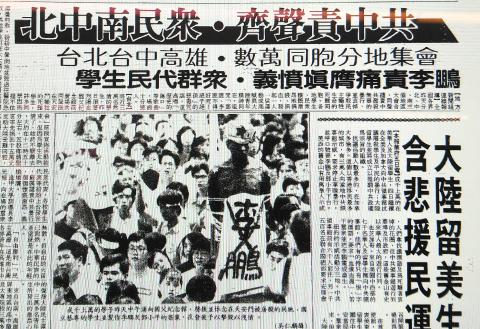
Photo: Wu Jen-lin, Taipei Times
“In Beiping, brave Chinese people are writing history with their blood,” says an on-site reporter using the former name of Beijing. “In Taipei, grief-stricken Chinese people are witnessing it with their tears.”
Watching these news clips brings the viewer back to a completely different political climate. Taiwan was two years removed from martial law and democracy was barely in its infant state, but its authoritarian government had actually been claiming to be a democracy for the previous decades while denouncing the Chinese Communist Party (CCP) as a brutal dictatorship. As such, all following claims of “democracy” are simply propaganda as Taiwan was pretty much just as authoritarian as China was at that point.
Beiping had been renamed Beijing decades prior, but the Chinese Nationalist Party (KMT), whose capital was in Nanjing when it ruled China, refused to acknowledge any alterations made after its retreat to Taiwan. And since the party claimed to rule both China and Taiwan, a massacre in Beijing was mourned as a domestic tragedy.
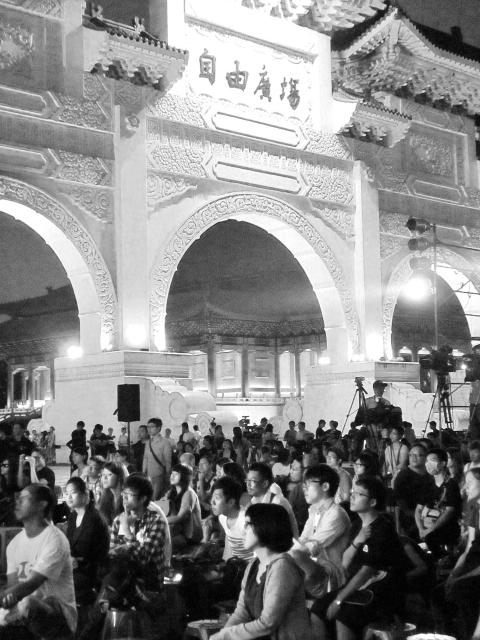
Photo courtesy of Wikimedia Commons
Memorials for the event are still held in Taiwan today, but the change in rhetoric over the past three decades has been remarkable.
TAIWAN REACTS
Taiwanese had been closely watching the developments in Tiananmen Square since unrest begin in April 1989, through the hunger strikes and declaration of martial law on May 20, with gatherings held to support the protesters.
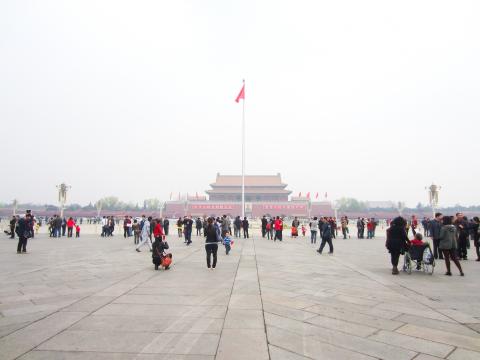
Photo courtesy of Wikimedia Commons
On June 2, the Liberty Times (the sister paper of the Taipei Times) ran a front page photo tiled “No fear of wind and rain” with students under umbrellas holding a sign that read, “We are against the Chinese Communists cracking down on democratic student protests.”
But nobody was prepared for what would happen on June 3. That night, a live-broadcast joint concert between Taipei and Beijing was interrupted at around 11pm as word came that the People’s Liberation Army (PLA) was closing in on Tiananmen square. The audience at Taipei’s Chiang Kai-shek Memorial Hall could clearly hear the Chinese protesters chanting slogans on the big screen. By midnight, word arrived that the PLA had opened fire on protesters as they made their way toward the square.
The concert was cut short, but the people in Taiwan remained at Chiang Kai-shek Memorial Hall, sitting down to protest in silence. By press time, the Liberty Times reported that more than 10,000 agitated civilians and celebrities were still on site.
The next day’s paper was plastered with editorials denouncing the violence as well as responses from government officials. President Lee Teng-hui (李登輝) publicly addressed the incident for the first time: “Although we have predicted these insane actions of the Chinese Communist Party, we still feel immense grief, anger and shock.”
“We believe that any government should be built upon the will of the people. Although the CCP robbed the mainland from us through violence and lies, the internal conflict and oppression of its people has not ceased in 40 years .... I, Teng-hui, with a heavy heart, call for the people around the world who love freedom and respect human rights to harshly condemn the CCP … The tyranny of the CCP is the utmost disgrace to Chinese all around the world.”
Government Information Office chief Shao Yu-ming (邵玉銘) said that the lifting of the ban for Taiwanese civilians and reporters to visit China been a catalyst for the Chinese to fight for freedom and democracy — but it is unfortunate that it was met with violence.
“Our responsibility is heavier than any country in the world. We have to fulfill our duty to let the whole world know about the bloody actions by the CCP,” he adds.
Many other groups spoke out, but the rhetoric was largely the same: denounce the communists while emphasizing the freedom and democracy of Taiwan (which did not really exist).
What’s interesting is even the Liberty Times followed the same formula. “As Chinese people, we also denounce the actions of the CCP, but rationally, we believe that terminating or delaying contact between both sides of the Taiwan Strait will only prolong this historic tragedy,” an editorial on June 5 stated.
However, the paper included comments from the Democratic Progressive Party calling to speed up the democratization process in Taiwan “to avoid a similar tragedy.”
“Fighting for freedom and democracy is something universal, and we of the local opposition can empathize with the protesters as we also constantly face threats and oppression,” said future president Chen Shui-bian (陳水扁), citing the 1979 Kaohsiung Incident and the 1988 farmer riots, both of which turned violent. Chen noted that at least the KMT troops did not open fire on protesters.
“The ruling government should draw a lesson from this incident and actively democratize Taiwan and bring the true freedom to the people before discontent boils over.”
WOUNDS OF HISTORY
The Taiwanese sprung into action, putting together vigils, fasts and fundraisers among other events in the following weeks.
On June 7, the United Daily News reported that thousands of cram school students near Taipei Main Station gathered in the area despite their looming college entrance exams, “signing petitions, making speeches, singing with tears in their eyes and donating funds.”
Emotions in Taiwan were so high that variety show host Hu Gua (胡瓜) became the target of public anger as people called the television station to accuse him of acting flippantly in the wake of such a tragedy.
There are many songs that are associated with the Tiananmen Square Massacre, most notably Wound of History (歷史的傷口), which was a collaboration between four major Taiwanese record companies and featured more than 100 popular singers, written and recorded in late May of 1989 to support the students in Beijing.
This song was written before the major crackdown took place, and was intended to be smuggled into China to boost protester morale. Tactics included faxing the lyrics and melody to China and handing cassette tapes to Chinese tourists at airports around the world.
“In just three to four days, public relations companies mobilized their entire staff and managed to transmit the song into the ears of the students at Tiananmen Square,” the Economic Daily News reported.
One of the promoters told the paper that a “successful movement requires people and clear slogans, but even more important is to have its own song to maintain morale. We could clearly see that the student movement in Tiananmen Square is missing this.”
The music video begins with protesters riding their bikes against a sea of fire, cutting to images of Tiananmen Square. The suona horn sounds off as the dramatic introduction segues to fast-paced guitar strumming.
“How much longer do we have to endure? How much longer do we have to keep silent? If tears can wash away the dust, if blood can be exchanged for freedom … Let tomorrow remember our rage of today, let the whole world see this wound of history.”
Taiwan in Time, a column about Taiwan’s history that is published every Sunday, spotlights important or interesting events around the nation that have anniversaries this week.
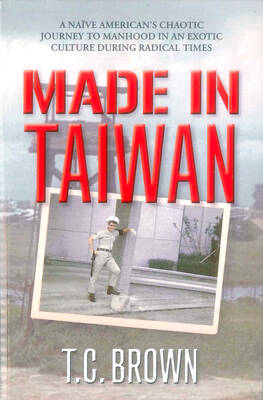
By 1971, heroin and opium use among US troops fighting in Vietnam had reached epidemic proportions, with 42 percent of American servicemen saying they’d tried opioids at least once and around 20 percent claiming some level of addiction, according to the US Department of Defense. Though heroin use by US troops has been little discussed in the context of Taiwan, these and other drugs — produced in part by rogue Chinese Nationalist Party (KMT) armies then in Thailand and Myanmar — also spread to US military bases on the island, where soldiers were often stoned or high. American military policeman
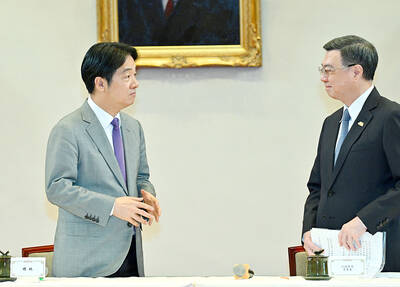
Under pressure, President William Lai (賴清德) has enacted his first cabinet reshuffle. Whether it will be enough to staunch the bleeding remains to be seen. Cabinet members in the Executive Yuan almost always end up as sacrificial lambs, especially those appointed early in a president’s term. When presidents are under pressure, the cabinet is reshuffled. This is not unique to any party or president; this is the custom. This is the case in many democracies, especially parliamentary ones. In Taiwan, constitutionally the president presides over the heads of the five branches of government, each of which is confusingly translated as “president”
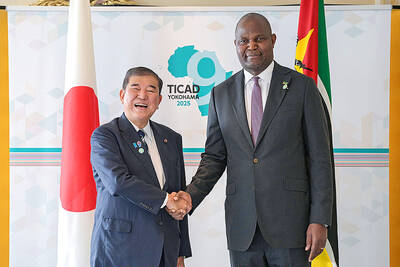
An attempt to promote friendship between Japan and countries in Africa has transformed into a xenophobic row about migration after inaccurate media reports suggested the scheme would lead to a “flood of immigrants.” The controversy erupted after the Japan International Cooperation Agency, or JICA, said this month it had designated four Japanese cities as “Africa hometowns” for partner countries in Africa: Mozambique, Nigeria, Ghana and Tanzania. The program, announced at the end of an international conference on African development in Yokohama, will involve personnel exchanges and events to foster closer ties between the four regional Japanese cities — Imabari, Kisarazu, Sanjo and
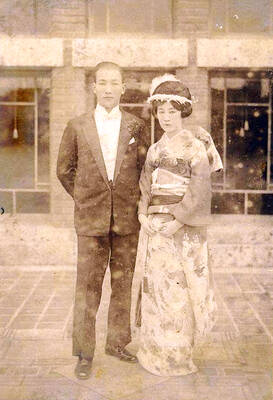
Sept. 1 to Sept. 7 In 1899, Kozaburo Hirai became the first documented Japanese to wed a Taiwanese under colonial rule. The soldier was partly motivated by the government’s policy of assimilating the Taiwanese population through intermarriage. While his friends and family disapproved and even mocked him, the marriage endured. By 1930, when his story appeared in Tales of Virtuous Deeds in Taiwan, Hirai had settled in his wife’s rural Changhua hometown, farming the land and integrating into local society. Similarly, Aiko Fujii, who married into the prominent Wufeng Lin Family (霧峰林家) in 1927, quickly learned Hoklo (commonly known as Taiwanese) and